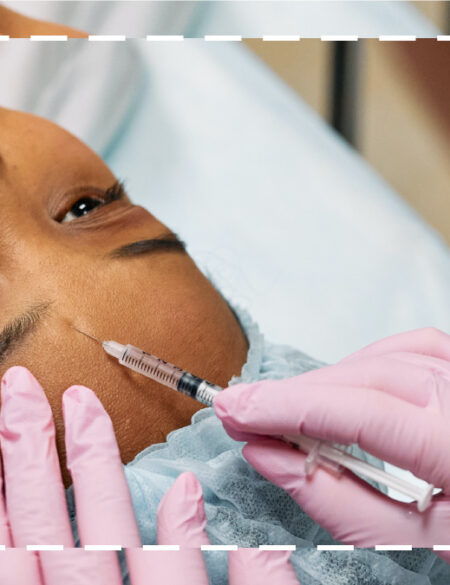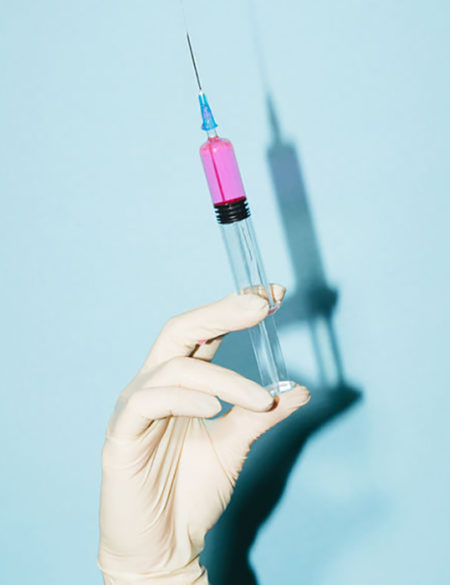What’s the deal with botox injections? When should you get it? How safe is it? We have a plastic surgeon answer your biggest questions about this popular treatment.
As you get older, you probably start hearing about Botox more and more. Perhaps your friend in her late 20s has started getting some mild injections as a “preventative” measure to ward off those inevitable forehead and smile lines. Or maybe you know someone in their 40s, 50s, or 60s who swears by the treatment. Whatever the case, we know Botox is a popular topic. So we asked you to send us your biggest questions about it.
We received so many great questions from our readers about if and when you should consider getting Botox. For answers, we reached out to Jonghan Cho, plastic surgeon and owner of the Seoul Plastic Surgery Clinic in Gangenung, Korea.
What does Botox do and how does it work?
Botox prevents wrinkles from deepening by temporarily suspending muscle movement. On a scientific level, Botox works by binding to and eliminating the bridges between neurons and muscles, preventing neurotransmitters from reaching the muscles and getting them to move.
If Botox eliminates those bridges, does that mean it’s harmful to your body?
No. Botox may remove the bridges, but your muscles naturally regenerate them again in 5-6 months. Also, when you get Botox, you inject only a tiny amount at a time and only in the places where you want it.
How much Botox should you get?
It really depends on the area and what your needs are. Typically, one vial has about 100 units of Botox. Depending on what you’re trying to target, you might use the entire vial on your face, which I consider to be the full amount for my patients. Personally, I tend to inject 15-30 units on the forehead, but there’s no set amount because how much you need entirely depends on the person.
Death from Botox is possible, but the lethal dose is around 100 vials. Where you inject Botox is also very important: If you inject too much in the wrong area of your neck, you might freeze the muscles that allow you to breathe, in which case it would become very dangerous. That’s why it’s important to get Botox with a qualified medical professional you trust.
Can Botox remove existing wrinkles or is it purely preventative?
If you want to remove existing wrinkles, you need to go the surgical route. Think laser, cutting off the sagging skin, or getting a facelift. Botox works by freezing the muscle, so what it can accomplish is prevent your face from becoming more wrinkled from making facial expressions, like raising your brows or smiling. So it’s preventative, not corrective.
How does Botox affect the overall health of your skin?
I’ve noticed that Botox tends to make the areas where Botox was injected slightly oilier (less shiny and more glowy) and tighter, most likely because Botox affects the oil glands in your skin. This effect tends to last as long as the Botox itself, so about 5-6 months.
Very rarely, people may express itchiness, most likely due to an allergic reaction to the proteins that are typically included in the formula. That said, Botox in general doesn’t harm your skin or create permanent damage because it does not permanently linger in your body.
What is the difference between Botox and fillers?
Once Botox is injected, it naturally dissolves inside your body in one week, which is the period it takes to suspend muscle function. Since your muscles need five to six months to recover and regenerate bridges, that’s when you feel that Botox is ‘working,’ even though Botox has disappeared in your body a long time ago.
Fillers, on the other hand, remain inside your body for a long period and do not have an impact on suspending muscle function.
Note that fillers can mean a lot of different things—there are kinds that do dissolve, like ones made of hyaluronic acid, which is popular today. Fillers also vary in terms of how long they last, so you can find ones that last a year or even longer.
You can get fillers to literally ‘fill out’ existing wrinkles. In addition to hyaluronic acid and other synthetic ingredients, you can even use your own fat to ‘fill out’ certain areas.
Can you use Botox to smooth crow’s feet, lines on your forehead, and neck wrinkles?
When you smile or make a facial expression, your skin folds, which makes the wrinkles deepen. Botox prevents muscle movement, so your wrinkles don’t deepen as much when you make a facial expression. Smiling often is what leads to crow’s feet, aside from aging of course, so Botox can prevent crow’s feet from getting worse. The same applies to the lines on your forehead and neck wrinkles, given that you inject an appropriate amount in the right place.
Can you use Botox to define your jawline?
Yes. Try touching the sides of your jaw. There’s a muscle that juts out when you chew called the masseter muscle. If you have a square jaw, it might be because your masseter muscle is very developed. If you get Botox in that area, it freezes the muscle, which over time helps shrinks the muscle due to inactivity. Think about bodybuilders—if they stop working out, in just a couple years, the size of their muscles shrink significantly.
You only need a small amount in a specific part of the jaw, so getting Botox there doesn’t mean you won’t be able to chew, though the strength of your jaw and how hard you can chew might be a little bit reduced. Some people have strong jaws that make them chew too hard, which leads to pain. So getting Botox in the jaw could be a temporary solution.
If you’re looking to get Botox to slim down your jaw, know that it’ll take about 1-1.5 months to show initial results. This makes sense if you think about the fact that skipping your workout one day doesn’t make you lose all your muscles overnight.
At what age should you get Botox?
There’s no research out there that suggests that there is a single best age to get Botox because it really depends on the individual. Some people just wrinkle faster than others. As you live your life, it’s inevitable that you smile, which leads to wrinkles. I’d say that if you’re not smiling, and your natural resting face is beginning to show some fine lines, then it’s a good time to start.
You can get Botox when you’re a teenager, too, and most likely, you won’t experience side effects. But it would be pointless because it’s very expensive.
What are the best brands for Botox?
There are a ton of different brands on the market because many countries make their own. One popular brand in Korea right now is Meditoxin, but the original Botox was created by a US company called Allergan.
One interesting brand is a German one called Xeomin. Unlike most Botox products that come with proteins in the formula, Xeomin comes with none. They claim that this ensures that your body doesn’t produce antibodies to the proteins, a process that can lower the effectiveness of Botox. But in my personal experience, there has been no noticeable difference compared to other brands when I used it on my patients.
It looks like Botox isn’t a permanent solution. Does this mean you need to continue getting it?
Yes, if you want to see results. If you don’t want to continue getting it, that’s totally fine. Your muscles will naturally recover and regain mobility, assuming that you get the right amount in the right place.
If you get Botox early in your life, does it make your face look artificial later in life? Do you have to do a lot of maintenance when you get older?
No. Botox doesn’t necessarily make your face look artificial. It just prevents wrinkles from deepening. Personally, I’ve been getting Botox regularly for 8.5 years. I would say that the only downside to Botox is that you probably won’t look your age because you don’t age as fast.
Would getting Botox be a problem for people like actresses who need to move their facial muscles?
It can potentially be a problem. For instance, it could be harder for you to frown or raise your brows to act surprised. But say that you’re shooting a TV show and it’s not one of those that run for a decade. You can just skip when you’re shooting and resume when you’re on break.
Can you get Botox while pregnant or planning on getting pregnant?
My recommendation would be no. Even though the effect of Botox is local because you’re targeting a specific area, there is a slight chance that it can spread to other parts of your body. Since you inject only a tiny amount at a time, under normal circumstances, even that wouldn’t necessarily be a huge problem. But if anything were to happen, you’d wonder if it’s due to Botox.
I’m not saying that getting Botox is inherently dangerous, but when it comes to pregnancy, I can’t guarantee 100% safety.
Are there any natural alternatives to Botox?
No.
What about skin care products that have Botox as an ingredient or deliver the same effect as Botox?
No, and if they claim to do that, they’re probably lying. The size of the proteins in Botox are fairly large, so there’s no way that Botox can be absorbed into your body through a topical treatment. It has to be injected.
Is Botox effective for migraines?
I would say so because there is a good amount of research supporting it, though I cannot say I have personally used Botox to treat migraines for my patients. Depending on the source of the migraine, you might get the injection in your temples, back, neck, or other areas.
Can you use Botox to correct droopiness?
No. For any kind of droopiness, the best solution is to go the surgery route. This applies to facial droopiness and droopy eyelids.








